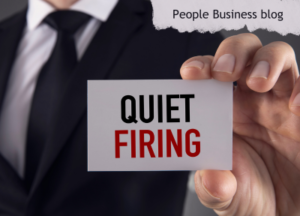Avoid quiet firing
 You are likely familiar with the term ‘quiet quitting’ which in August 2022 the BBC referred to as “doing only what your job demands and nothing more. Quitting doing anything extra.” There’s been much debate around the term, raising questions such as should people be expected to do more than they are paid for?
You are likely familiar with the term ‘quiet quitting’ which in August 2022 the BBC referred to as “doing only what your job demands and nothing more. Quitting doing anything extra.” There’s been much debate around the term, raising questions such as should people be expected to do more than they are paid for?
However, the question we’re asking today is have you heard of ‘quiet firing’? A recent Harvard Business Review article referred to it as “intentionally creating a hostile work environment that encourages people to leave ‘voluntarily’”, with the article also stating that “more recently, companies such as Meta and Tesla increasingly seem to be using quiet firing as a workforce reduction strategy on a wider scale.”
People Business Senior HR Consultant, Lucilla Kearsey comments, “We all know times are tough and organisations now more than ever are faced with calls for cost-cutting, but purposefully giving employees a reason to leave a company is damaging not only to the employee but also to the organisation’s brand and reputation. It also places a company at risk of a constructive unfair dismissal claim.”
If an organisation needs to reduce their workforce and consider making redundancies, what steps should they be taking?
Lucilla adds, “While redundancy is a potentially fair reason for dismissal, for it to be fair, there must be a genuine redundancy situation and the employer must follow a fair procedure in carrying out the dismissal, including consulting on an individual basis and/or collective consultation obligations, where these apply.”
As a minimum, the process should include the following steps:
- Prepare and plan – Assess whether redundancy is necessary or not. Identify the business reasons for reducing the workforce, as these will need to be explained as part of the consultations.
- Determine those for selection – There are no fixed rules about how a redundancy pool should be defined. However, failure to consider the pool correctly is likely to give rise to unfair dismissal claims e.g. only identifying employees who are under-performing.
- Consider volunteers – Employers can ask for volunteers in the early stages of the redundancy process but if there are insufficient numbers, you may still need to proceed with compulsory redundancies.
- Consult employees – This is essential and is a legal requirement. Consultation with affected employees and their representatives should include ways of avoiding redundancies and the criteria for selection.
- Make selection – Once consultations are complete employees can be given notice of redundancy. This should include the employee’s notice period, leaving date, redundancy and holiday pay and any other sums due.
- Suggest appropriate employment alternative – This may be identified as part of the consultation but it must fulfil the legal tests of being a genuine suitable alternative. If it is, the employee must be given a trial. If it isn’t a genuine alternative role then the employee can refuse without forfeiting their right to their statutory ‘package’.
- Present opportunity for individuals to appeal/dismiss – Employees should be given the opportunity to challenge decisions selecting them for redundancy dismissal.
- Provide redundancy payment – An employee must have been employed for two years to qualify for statutory redundancy payment. The amount will depend on their age, length of service and gross week’s pay and is capped at 20 years and the prevailing government rate.
The final stage and one that should not be forgotten…
- Show empathy – A redundancy situation has significant impact on the morale, mental health and wellbeing of both the employees who are subject to such a process as well as those who remain. Although it may be impossible to avoid redundancies it is important that it is approached with compassion and employees are treated with dignity, respect and kindness throughout. Regular, honest two-way communication from line managers is vital and information given out should be clear and understood by those concerned. Immediate and ongoing support should be made available to support the employee’s health and wellbeing during what will be an upsetting and unsettling time.
Companies can also support individuals exiting the business with outplacement guidance, helping them move on to the next stage of their career. If you’d like the expert advice of one of our experienced HR consultants or are interested in our outplacement coaching please get in touch.




